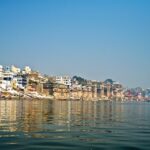Ganga is National River of India. Ganga river was declared as the National river of India on 4th November 2008 by the Prime Minister Manmohan Singh. The Ganga Action plan was originally initiated by India’s Former Prime Minister Rajiv Gandhi in 1986. National Mission for Clean Ganga (NMCG) is the implementation arm of the National Ganga River Basin Authority. The governing council and Executive Committee are two tiers of the NMCG.

The five confluences of Ganga River are revered as sacred and they are:
- Vishnu prayag – Dhauliganga joins the Alaknanda
- Nand prayag – River Mandakini joins
- Karna prayag – River Pindar joins
- Rudraprayag – River Mandakini joins
- Devprayag – Bhagirathi river and Alaknanda river form Ganga river
The Ganges is a lifeline to hundreds of millions of people who live in its basin and depend on it for their daily needs. The name Ganges is used for the river between the confluence of the Bhagirathi and Alaknanda rivers.
The National River of India Ganga flows through India and Bangladesh. The river flows through the Himalayas, Gangetic plains and empties into the Bay of Bengal. In Indian traditions and culture, river Ganga is personified as Goddess Ganga. It is a revered belief that to remit sins, one has to take a dip in river Ganga. Ganga is also mentioned in one of the four Vedas – Rigveda. The River starts from the Gangotri Glacier in the name of Bhagirathi River.Many scared places are located alongside the stretches of Ganga River –
- Gangotri
- Haridwar
- Prayagraj
- Varanasi
- Kali Ghat
The Ganga, often known as the Ganges, is India’s longest river, running 2510 kilometres across mountains, valleys and plains. The Bhagirathi River originated in the Himalayan snowfields of the Gangotri Glacier. The river has two dams, one is Haridwar and the other is Farakka. The Ganges river Dolphin is a critically endangered species that only lives in this river.
